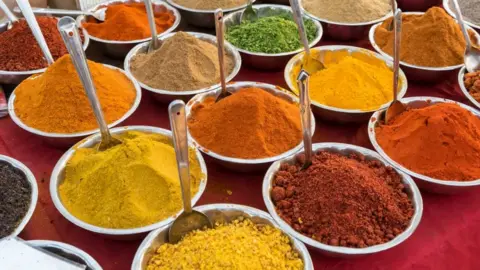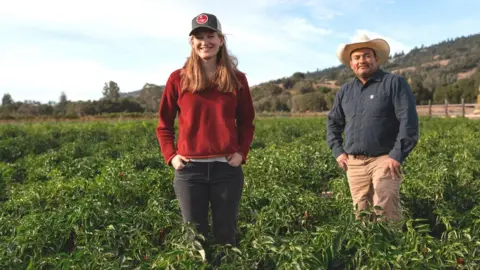Spice sales boom as home cooks get more adventurous
 Getty Images
Getty ImagesWhat are you planning to cook when you next make something from scratch in the kitchen? A nice bit of salmon? Lamb chops? Or maybe a vegan pasta dish?
Whatever you have in mind, it will probably involve using some form of spice or herb - whether it's just a sprinkle of freshly ground black pepper, a hint of thyme, or a blizzard of cumin.
"Spice is the key," says UK TV chef and cookery book writer Parveen Ashraf - also known as the "Spice Queen". "It livens up food, gives it flavour, it makes it come alive."
She believes there's a clear current winner in the battle for our taste buds. "The spice I think that's really taken over is turmeric," she says. "Now next time you go out, you notice everything that's got turmeric in it. It's everywhere."
If you are a big fan of spicy food, then buying spices for your cooking is something you take for granted. Yet industry expert Donald Pratt says that demand for herbs and spices has actually risen strongly in recent years.
Mr Pratt, who is in charge of sourcing for US giant McCormick - the biggest spices and herbs company on the planet - says there are a number of factors behind the current strength of the market.
"We think the pandemic accelerated the aspect of everyone being a bit more sophisticated in the kitchen," he says.
"And you see younger generations getting into heat and flavour explorations all over the place. We see it across the board globally as cultures and cuisines come together."
He adds that increased health concerns are also playing a part. "The desire to eat healthier is a global trend. So more home cooking with natural ingredients, and replacing salt, sugar and fats with flavour from herbs and spices."
 Parveen Ashraf
Parveen AshrafSuch is the increased use of herbs and spices in cooking around the world, that one report estimates that the global market will be worth $126bn (£103bn) by the end of this year, up from $79bn in 2022.
Ms Ashraf adds that the increased use of different spices is being fuelled by people posting photos, videos and recipes of their cooking on social media. "Suddenly you've got recipes that travel around the world at the touch of your fingertips," she says.
In addition, Ms Ashraf points to studies which suggest that spices such as turmeric, cumin and cinnamon have direct health benefits, which she says further adds to their popularity.
On a country-by-country basis the biggest producer of spices is India. It is also the largest exporter, and in the financial year 2021-22 the value of its exports totalled $4.1bn. Other major spice-exporting countries include Indonesia, China, Vietnam and Brazil.
But even if your country earns millions exporting spices, you won't necessarily make a decent living working in the industry at the farm level. In fact, some critics like Sana Javeri Khadri say poverty is endemic to the sector.
 Diaspora Co
Diaspora CoShe's the Mumbai-based founder of spice trading firm Diaspora Co. Her venture now buys spices from 150 farms across India and Sri Lanka, and aims to combat low pay in the industry. "Farmers are getting paid very little," says Ms Khadri.
To try to lift wages in the sector she is disrupting the traditional trading model for Indian spice, by buying directly from farms instead of going via middlemen. As a result she says that she can pay the farm owners four times as much.
She adds that in turn she is encouraging the farm owners to pay more to their workers out in the fields, "with moderate success". She wants to see wages go up from about 300-350 rupees a day ($3.60-$4.20; £3-£3.50) to 500-600 rupees a day.
Ms Khadri also wants to see farm owners improve living conditions for workers, which in poorer regions can be "absolutely awful".

Global Trade

Mr Pratt says McCormick takes a leadership role in raising standards across the industry, especially when it comes to stamping out worker exploitation and promoting sustainability.
"What we're bringing - whether it be technically supporting good agricultural practices, or how to introduce biodiversity into their supply chains, or how to help them to improve their living conditions - are all part of our contribution," he says.
"We're in the industry to figure out how to make it even more resilient, so 20, 30, 40 years from now, farming communities are still delivering wholesome herbs and spices."
In California, Krissy Scommegna is the co-owner of Booneville Barn Collective, which sells dried chillies and other products made from crops grown at its seven-acre farm in Anderson Valley, some 125 miles north of San Francisco.
 Nikolas Zvolensky
Nikolas ZvolenskyShe says that higher energy bills and other inflationary pressures are having an impact on the business, as they are on other farms and food producers.
"We're trying to figure out how we can internalise some of the increased cost, instead of having to raise prices on people," says Ms Scommegna. "No-one wants to raise the price right now, and consumers don't want to see a higher price."
TV chef Ms Ashraf believes that even with the difficulties facing some in the spice trade, demand from consumers will only grow and grow.
She points to her own children as a sign of things to come. "Their palates are more international than mine was [at that age] and I think their children will be even more au fait with food from different cultures."
